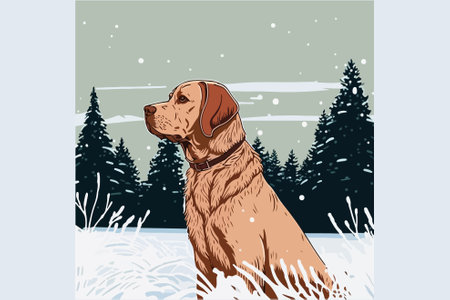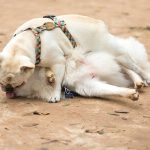1. Understanding Why Dogs Shed
Dog shedding is a natural process that helps your furry friend get rid of old or damaged hair. While some breeds shed more than others, all dogs go through this cycle to maintain a healthy coat. Understanding the reasons behind shedding can help you manage it more effectively in your home.
Breed Tendencies and Shedding Levels
Different dog breeds have different shedding patterns. Some breeds, like Labrador Retrievers and German Shepherds, are known for heavy shedding, while others, such as Poodles and Bichon Frises, shed very little due to their curly or hypoallergenic coats.
| Shedding Level | Common Breeds |
|---|---|
| High Shedding | Labrador Retriever, German Shepherd, Siberian Husky |
| Moderate Shedding | Corgi, Golden Retriever, Border Collie |
| Low Shedding | Poodle, Maltese, Shih Tzu |
Seasonal Shedding Factors
Many dogs experience seasonal shedding, especially those with double coats. In the spring, dogs shed their thick winter coat to prepare for warmer weather. In the fall, they shed their lighter summer coat to make way for a thicker winter coat. If you notice excessive fur around your home during these times of the year, seasonal shedding may be the reason.
The Role of Health in Shedding
A dogs overall health also plays a role in how much they shed. Poor nutrition, allergies, stress, and underlying medical conditions can contribute to excessive fur loss. If you notice bald patches or sudden increases in shedding, its best to consult a veterinarian to rule out any health concerns.
2. Proper Grooming Techniques to Reduce Shedding
Regular grooming is one of the most effective ways to manage your dogs shedding and keep loose fur under control. By using the right brushing techniques, selecting the best grooming tools, and maintaining a proper bathing routine, you can significantly reduce the amount of hair that ends up on your floors and furniture.
Brushing Routines: How Often Should You Brush?
The frequency of brushing depends on your dogs breed, coat type, and shedding level. Here’s a general guideline to follow:
| Coat Type | Brushing Frequency |
|---|---|
| Short-haired breeds (Labrador, Beagle) | 1-2 times per week |
| Medium-haired breeds (Golden Retriever, Border Collie) | 3-4 times per week |
| Long-haired breeds (Shih Tzu, Afghan Hound) | Daily brushing |
| Double-coated breeds (Husky, German Shepherd) | Daily during shedding season |
Best Grooming Tools for Shedding Control
Using the right grooming tools can make a big difference in managing shedding. Here are some must-have tools:
- Slicker Brush: Great for removing loose fur and detangling coats.
- Deshedding Tool: Designed to reach deep into the undercoat and remove excess hair before it sheds.
- Bristle Brush: Ideal for short-haired dogs to remove surface hair and distribute natural oils.
- Rubber Grooming Mitt: Works well for massaging the skin while lifting loose hair from short coats.
Bathing Tips to Keep Shedding Under Control
A regular bathing schedule helps loosen dead hair and keeps your dog’s coat clean and healthy. Follow these tips for effective bathing:
- Use a Deshedding Shampoo: Special formulas help reduce excessive shedding by strengthening hair follicles.
- Bathe Every 4-6 Weeks: Frequent baths help wash away loose fur but avoid over-bathing as it may dry out the skin.
- Brush Before and After Bathing: Brushing before removes excess loose hair, while brushing after helps keep the coat smooth and tangle-free.
- Rinse Thoroughly: Any leftover shampoo residue can cause skin irritation, leading to more shedding.
The Importance of a Healthy Coat
A well-groomed dog not only looks great but also sheds less. Regular brushing, proper bathing, and using high-quality grooming tools will help minimize shedding and keep your home cleaner. Establishing a consistent grooming routine will ensure your pup stays comfortable while reducing the amount of fur floating around your house.

3. Diet and Nutrition for a Healthier Coat
What your dog eats plays a significant role in the health of their coat and the amount of shedding you have to deal with. A well-balanced diet packed with essential nutrients can help strengthen hair follicles, reduce excessive shedding, and promote a shiny, healthy coat.
Essential Nutrients for Coat Health
Your dogs diet should include key nutrients that support skin and coat health. Below are some important components to look for in their food:
| Nutrient | Benefits for Coat Health | Common Sources |
|---|---|---|
| Omega-3 & Omega-6 Fatty Acids | Reduces inflammation, improves skin hydration, and promotes a shiny coat. | Fish oil, flaxseed, salmon, chicken fat |
| Protein | Supports hair growth and strengthens hair follicles. | Chicken, beef, fish, eggs |
| Vitamins A & E | Encourages cell regeneration and protects against dry skin. | Carrots, sweet potatoes, leafy greens |
| Zinc | Prevents dry, flaky skin and supports overall coat health. | Pumpkin seeds, whole grains, red meat |
| Biotin | Aids in hair growth and reduces breakage. | Egg yolks, liver, nuts |
The Role of Hydration in Shedding Control
Proper hydration is just as important as a nutritious diet when it comes to reducing shedding. Dehydration can lead to dry skin, which increases shedding and makes your dogs fur more brittle. Ensure your pup always has access to fresh water and consider adding moisture-rich foods like wet dog food or water-packed fruits (such as cucumbers or watermelon) to their diet.
Choosing the Right Dog Food
If you notice excessive shedding despite regular grooming and care, it might be time to evaluate your dogs food. Look for high-quality options with real meat as the first ingredient and minimal fillers like corn or soy. Grain-free diets may also benefit some dogs with allergies or sensitivities that contribute to skin irritation and excess fur loss.
Signs Your Dogs Diet May Need an Upgrade:
- Dull or brittle coat
- Patches of hair loss
- Dry, flaky skin
- Excessive scratching or licking
- Persistent shedding despite regular brushing
Supplements for a Healthier Coat
If your dogs diet lacks essential fatty acids or other vital nutrients, supplements can be a great way to improve coat health. Fish oil capsules, biotin supplements, or specially formulated skin and coat chews can provide the extra boost needed to keep shedding under control.
By focusing on proper nutrition and hydration, you can significantly reduce excessive shedding while keeping your furry friend’s coat soft, shiny, and healthy.
4. Managing Shedding in Your Home
Keeping your home free from excessive dog fur can feel like a never-ending battle, but with the right strategies, you can significantly reduce shedding-related mess. Here are some practical solutions to help maintain a cleaner living space.
Regular Cleaning Tips
Consistent cleaning is key to managing pet hair buildup. Focus on high-shedding areas and use the right tools for effective fur removal.
Best Cleaning Tools for Pet Hair
| Tool | Usage |
|---|---|
| Lint Roller | Quickly removes fur from clothing and upholstery. |
| Rubber Broom | Great for gathering loose hair on hard floors. |
| Vacuum with HEPA Filter | Picks up pet hair while improving air quality. |
| Damp Microfiber Cloth | Easily wipes away fur from surfaces. |
Protecting Your Furniture
Your furniture tends to collect the most dog hair, so taking preventive measures can save you time and effort when cleaning.
Couch Covers and Washable Fabrics
- Couch Covers: Use machine-washable covers to trap fur before it settles into upholstery.
- Select Pet-Friendly Fabrics: Leather and tightly woven fabrics repel hair better than materials like velvet or corduroy.
- Paw Towels: Keep a towel near entrances to wipe off loose fur before your dog lounges on furniture.
Air Filtration Options
A good air filtration system helps capture airborne pet dander and reduces allergens in your home.
The Best Air Purifiers for Homes with Dogs
| PURIFIER TYPE | BENEFITS |
|---|---|
| HEPA Filter Purifier | Catches tiny hair particles and allergens effectively. |
| Ionic Air Purifier | Reduces airborne pet dander but may create ozone as a byproduct. |
| Ash-Free Carbon Filter Purifier | Tackles odors in addition to filtering out pet hair. |
Tackling dog shedding at home requires a combination of regular cleaning, protective measures, and air filtration. By integrating these methods into your routine, you can enjoy a cleaner, fur-free living space while keeping your furry friend happy and comfortable.
5. When Excessive Shedding Might Be a Health Concern
Shedding is a natural part of a dogs life, but sometimes, excessive fur loss can indicate an underlying health problem. If you notice unusual shedding patterns or other concerning symptoms, it may be time to consult your veterinarian.
Signs of Abnormal Shedding
While all dogs shed to some extent, certain signs can indicate that your dogs shedding is not normal. Here are some red flags to watch for:
| Signs of Abnormal Shedding | Possible Causes |
|---|---|
| Bald patches or thinning fur | Allergies, infections, hormonal imbalances |
| Red, inflamed, or irritated skin | Skin infections, parasites, food allergies |
| Excessive scratching or licking | Fleas, mites, environmental allergies |
| Dull or brittle coat | Poor diet, vitamin deficiencies |
| Sudden increase in shedding | Stress, illness, hormonal changes |
Common Health Issues That Cause Excessive Shedding
If your dog is shedding more than usual and showing any of the symptoms above, it could be due to an underlying health issue. Some common conditions that contribute to excessive fur loss include:
- Allergies: Dogs can develop allergies to food, pollen, dust, or household products, leading to itchy skin and hair loss.
- Parasites: Fleas, ticks, and mites can cause severe itching and lead to excessive shedding.
- Hormonal Imbalances: Conditions like hypothyroidism or Cushing’s disease can affect coat health and cause abnormal hair loss.
- Nutritional Deficiencies: A lack of essential vitamins and nutrients in a dogs diet can lead to poor coat quality and increased shedding.
- Skin Infections: Bacterial or fungal infections can cause inflammation and result in hair loss.
When to See a Veterinarian
If you suspect that your dogs shedding is linked to a health issue, its important to seek veterinary advice. You should schedule an appointment if you notice:
- Persistent bald spots or severe thinning of the coat
- Sores, scabs, or excessive redness on the skin
- A sudden change in shedding patterns without any seasonal explanation
- Your dog excessively licking, biting, or scratching at their skin
How Your Vet Can Help
Your veterinarian will likely perform a physical exam and may run tests such as skin scrapings, allergy tests, or blood work to determine the root cause of the excessive shedding. Based on the diagnosis, they may recommend treatments such as dietary changes, medicated shampoos, supplements, or medications to address underlying conditions.
Maintaining Your Dog’s Coat Health
The best way to prevent excessive shedding due to health issues is through regular vet checkups and a well-balanced diet. Ensuring your dog gets proper nutrition and grooming can go a long way in keeping their coat healthy and reducing unnecessary hair loss.
If youre ever unsure about your dogs shedding patterns, its always better to consult with a veterinarian for peace of mind.


